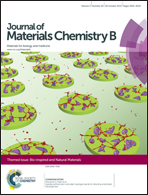Development and characterization of polyethylene glycol–carbon nanotube hydrogel composite†
Abstract
Carbon nanotube (CNT)–hydrogel composites are attractive for a variety of neural tissue engineering and drug delivery applications as well as biosensor coatings, transducers and leads. Both materials contribute unique and beneficial properties to the composites. Hydrogels are an excellent mimic of the extracellular matrix due to their hydrophilicity, viscoelasticity and biocompatibility. CNTs, on the other hand, can impart electroconductivity to otherwise insulating materials, improve mechanical stability and guide neuronal cell behavior as well as elicit axon regeneration. Not surprisingly, there has been a surge in the development of various CNT–hydrogel composites including both natural and synthetic polymers. Here, we describe a CNT–polyethylene glycol (PEG) hydrogel composite where the CNTs are entrapped in the hydrogel phase during gelation. The hydrogel crosslinking reaction is based on Michael-type addition which is ideal for in situ cell and protein encapsulation. To adequately disperse the highly hydrophobic CNTs in the aqueous polymer solution, we used sonication and surfactants, where bovine serum albumin was found to be an effective and non-cytotoxic dispersant. We demonstrate that the inclusion of the CNTs impeded the hydrogel crosslinking leading to longer gelation times, higher swelling and porosity, and lower storage modulus above a threshold CNT concentration. As anticipated, composite hydrogel resistivity decreased with the incorporation of CNTs and was dependent on both CNT loading and dispersion. Importantly, unlike the PEG hydrogel alone, the PEG–CNT hydrogel composite was capable of supporting high neural cell viability where the CNTs provided sites for cell attachment.

- This article is part of the themed collection: Bio-inspired and natural materials

 Please wait while we load your content...
Please wait while we load your content...